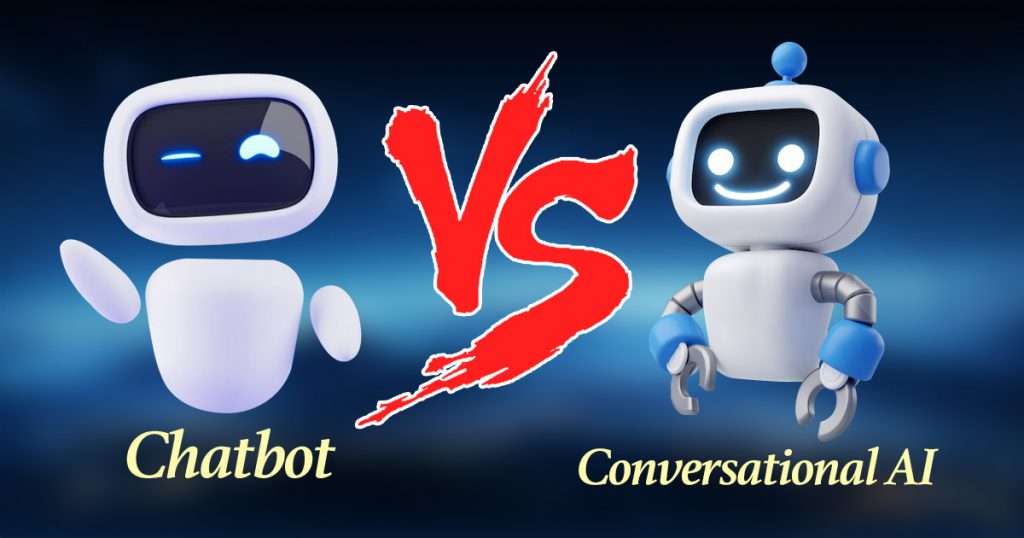Many businesses use automated tools to help with customer service and communication. Two common technologies in this area are chatbots and conversational AI. Despite their frequent interchange, these terms hold significant distinctions. To know which one is better suited for your needs, you need to understand the difference between chatbots and conversational AI.
What is a Chatbot?
A chatbot is a type of computer program that replicates user discussions. Most chatbots use pre-set rules and responses to answer common questions or perform simple tasks. For example, a chatbot might help you reset your password, check store hours, or answer frequently asked questions (FAQs).
Chatbots work best for straightforward tasks. Experts predict the global chatbot market will hit $15.4 billion by 2030. They’re programmed to respond to specific keywords or phrases and can’t understand complex or open-ended questions. Because of this, chatbots can sometimes feel limited if you ask something outside of their programmed knowledge.
Common Uses for Chatbots
- Customer Support: Answering basic questions like “Where’s my order?” or “What’s your return policy?”
- Sales Assistance: Helping customers find products or navigate a website.
- FAQ Assistance: Quickly providing answers to common inquiries.
What is Conversational AI?
Conversational AI expands beyond simple chatbots. Understanding human language is achieved through the application of modern technologies such as Natural Language Processing (NLP) and Machine Learning (ML). This enables conversational AI to engage in more meaningful and nuanced interactions with users.
Unlike chatbots, conversational AI systems don’t rely on pre-programmed answers. They can analyze the meaning of words, comprehend context, and even learn from previous exchanges. For instance, conversational AI can handle customer service queries that involve multiple steps or complicated instructions.
Conversational AI is commonly used in virtual assistants such as Amazon Alexa, Google Assistant, and Siri.
Key Technologies Behind Conversational AI
- Natural Language Processing (NLP): Allows the machine to understand and interpret human language.
- Machine Learning (ML): The system can improve over time by learning from prior talks.
- Voice Recognition: Allows the system to understand spoken commands rather than only text.
Differences Between Chatbot and Conversational AI
Understanding the difference between chatbots and conversational AI is crucial when choosing the right tool for your business. Here’s how they differ:
1. Understanding of Language
Chatbot: Can only handle specific questions or commands it’s programmed to recognize.
Conversational AI: Understands and responds to natural language, allowing for greater flexibility in discussion.
2. Complexity of Interaction
Chatbot: Handles basic, rule-based conversations. If the conversation goes off-script, the chatbot may not be able to help.
Conversational AI: Manages complex conversations and understands context, making it ideal for handling more difficult or multi-step tasks.
3. Learning Capability
Chatbot: Stays static—once programmed, it doesn’t change.
Conversational AI: Learns from interactions and improves its responses over time.
4. Use of Technology
Chatbot: Uses simple decision trees or scripts to guide the conversation.
Conversational AI: Using AI technologies such as NLP and machine learning to better interpret and respond to user input.
5. Context Awareness
Chatbot: Minimal context retention.
Conversational AI: Maintains context throughout conversations.
Chatbot vs Conversational Agent
A conversational agent is a broader term that can refer to either a chatbot or conversational AI. However, when comparing chatbot and conversational agents, conversational agents tend to have more advanced features, especially when powered by AI. They can handle text and voice interactions, making them versatile tools for customer service, personal assistants, and more.
While chatbots focus on handling simple tasks, conversational agents can engage in more human-like interactions, thanks to the AI behind them.
Conversational AI vs. Chatbots: Which is Right for You?
When deciding between conversational AI and chatbots, it is critical to examine your company’s needs. Here are some guidelines to help you decide:
Use a Chatbot If:
- You need to handle basic tasks: Chatbots are ideal for answering repetitive questions or helping customers with simple requests.
- You’re on a budget: Chatbots are generally more affordable and easier to implement than conversational AI.
- You want fast setup: Chatbots can be set up quickly, making them perfect for straightforward projects.
Use Conversational AI If:
- You need to manage complex tasks: If your business handles complicated queries, conversational AI’s ability to understand and learn makes it the better choice.
- You want personalized experiences: Conversational AI can offer tailored responses based on previous interactions with customers.
- You need scalability: As your business grows, conversational AI can handle a larger volume of complex interactions without losing quality.
Pros and Cons of Chatbot and Conversational AI
Pros of Chatbots:
- Cost-effective: Less expensive to build and maintain.
- Quick Setup: Easy to implement for simple tasks.
- Good for Basic Queries: Handles common questions efficiently.
Cons of Chatbots:
- Limited Flexibility: Can’t handle complex or off-script conversations.
- No Learning Capability: Doesn’t improve over time.
Pros of Conversational AI:
- Natural Conversations: Can simulate human-like interaction.
- Learns Over Time: becomes smarter with every interaction.
- Handles Complexity: Ideal for solving complicated problems.
Cons of Conversational AI:
- Higher Cost: More expensive to develop and maintain.
- More Time-Intensive: Requires more time to set up and train.
Chatbot vs Conversational AI: Making the Right Choice
Your choice depends on your business’s needs and complexity. Chatbots are perfect for handling simple, direct tasks, while conversational AI is designed for more advanced interactions, capable of understanding context and learning over time.
By understanding the difference between chatbots and conversational AI, you can make an informed decision. Whether you choose a basic chatbot or a sophisticated conversational agent, implementing the right solution will help improve customer satisfaction and streamline your business operations.

